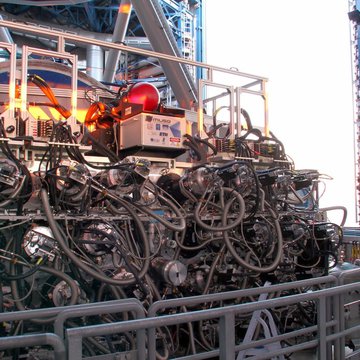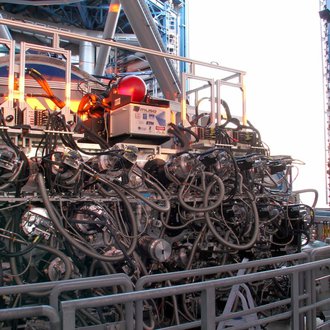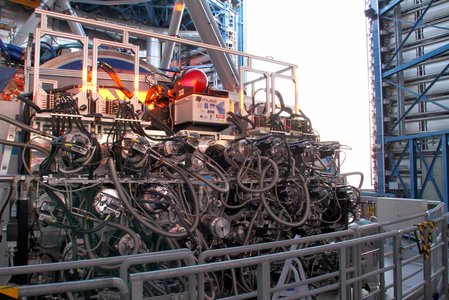First Light for MUSE
A new innovative instrument called MUSE (Multi Unit Spectroscopic Explorer) has been successfully installed on ESO’s Very Large Telescope (VLT) at the Paranal Observatory in northern Chile. MUSE has observed distant galaxies, bright stars and other test targets during the first period of very successful observations.
Following testing and preliminary acceptance in Europe in September 2013, MUSE was shipped to ESO’s Paranal Observatory in Chile.
The leader of the team and principal investigator for the instrument, Roland Bacon from the Centre de Recherche Astrophysique de Lyon expressed his feelings: "It has taken a lot of work by many people over many years, but we have done it! It seems strange that this seven-tonne collection of optics, mechanics and electronics is now a fantastic time machine for probing the early Universe. We are very proud of the achievement — MUSE will remain a unique instrument for years to come.”
MUSE’s science goals include delving into the early epochs of the Universe to probe the mechanisms of galaxy formation and studying both the motions of material in nearby galaxies and their chemical properties. It will have many other applications, ranging all the way from studies of the planets and satellites in the Solar System, through the properties of star-forming regions in the Milky Way and out to the distant Universe.
++ For the full text version please refer to the ESO website ++
Science contact AIP:
Dr. Andreas Kelz (MUSE local project manager), akelz@aip.de, +49 331-7499-640
Prof. Dr. Lutz Wisotzki (MUSE instrument scientist), lwisotzki@aip.de
Media contact AIP:
Kerstin Mork, presse@aip.de, +49 331-7499-469
Further information:
A new innovative instrument called MUSE (Multi Unit Spectroscopic Explorer) has been successfully installed on ESO’s Very Large Telescope (VLT) at the Paranal Observatory in northern Chile. MUSE has observed distant galaxies, bright stars and other test targets during the first period of very successful observations.
Following testing and preliminary acceptance in Europe in September 2013, MUSE was shipped to ESO’s Paranal Observatory in Chile.
The leader of the team and principal investigator for the instrument, Roland Bacon from the Centre de Recherche Astrophysique de Lyon expressed his feelings: "It has taken a lot of work by many people over many years, but we have done it! It seems strange that this seven-tonne collection of optics, mechanics and electronics is now a fantastic time machine for probing the early Universe. We are very proud of the achievement — MUSE will remain a unique instrument for years to come.”
MUSE’s science goals include delving into the early epochs of the Universe to probe the mechanisms of galaxy formation and studying both the motions of material in nearby galaxies and their chemical properties. It will have many other applications, ranging all the way from studies of the planets and satellites in the Solar System, through the properties of star-forming regions in the Milky Way and out to the distant Universe.
++ For the full text version please refer to the ESO website ++
Science contact AIP:
Dr. Andreas Kelz (MUSE local project manager), akelz@aip.de, +49 331-7499-640
Prof. Dr. Lutz Wisotzki (MUSE instrument scientist), lwisotzki@aip.de
Media contact AIP:
Kerstin Mork, presse@aip.de, +49 331-7499-469
Further information:
Images
MUSE at the VLT.
Big screen size [1000 x 666, 180 KB]
Original size [1162 x 775, 230 KB]





